Dementia Strategy in Ireland
VerifiedAdded on 2021/02/20
|14
|5104
|45
AI Summary
Contribute Materials
Your contribution can guide someone’s learning journey. Share your
documents today.
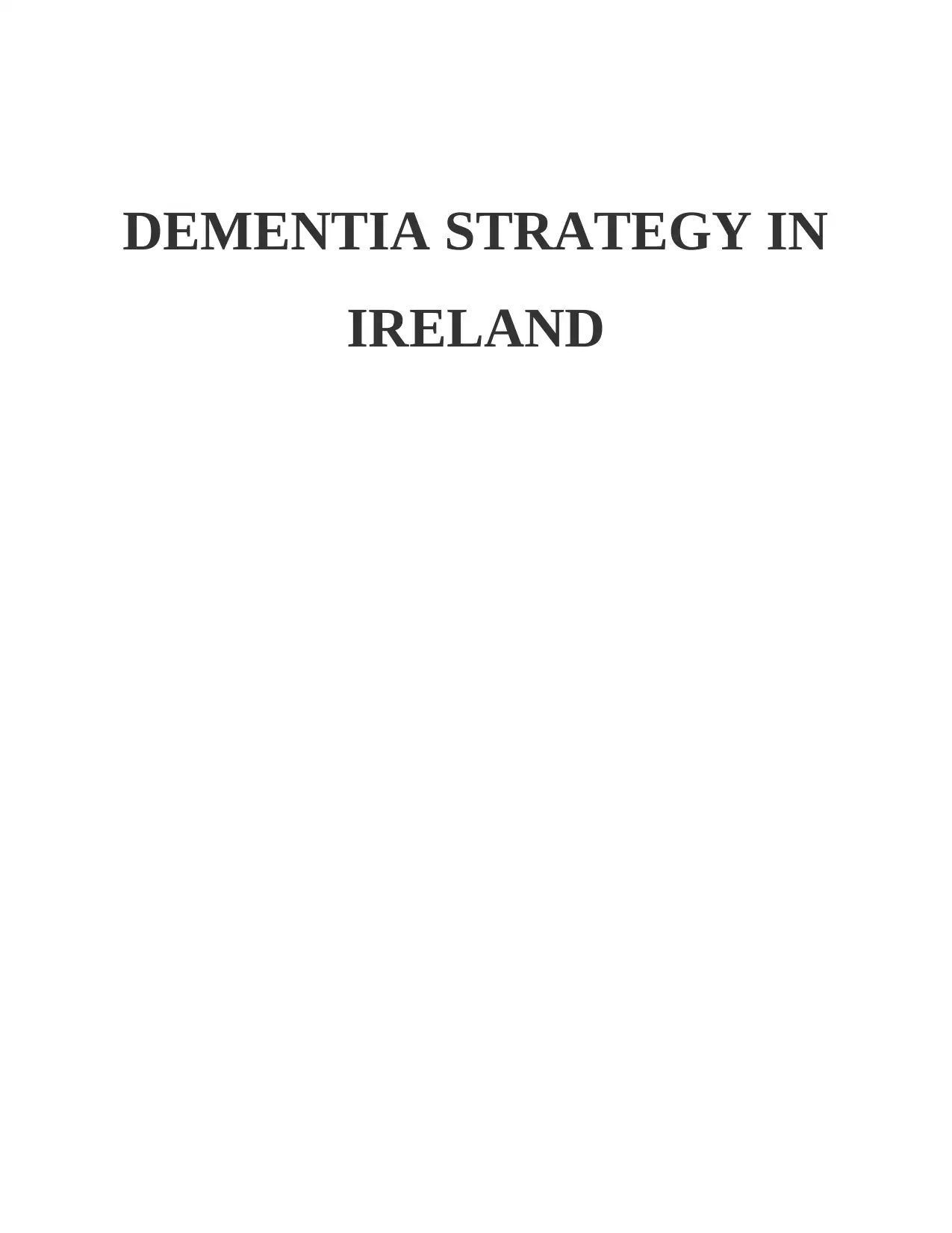
DEMENTIA STRATEGY IN
IRELAND
IRELAND
Secure Best Marks with AI Grader
Need help grading? Try our AI Grader for instant feedback on your assignments.
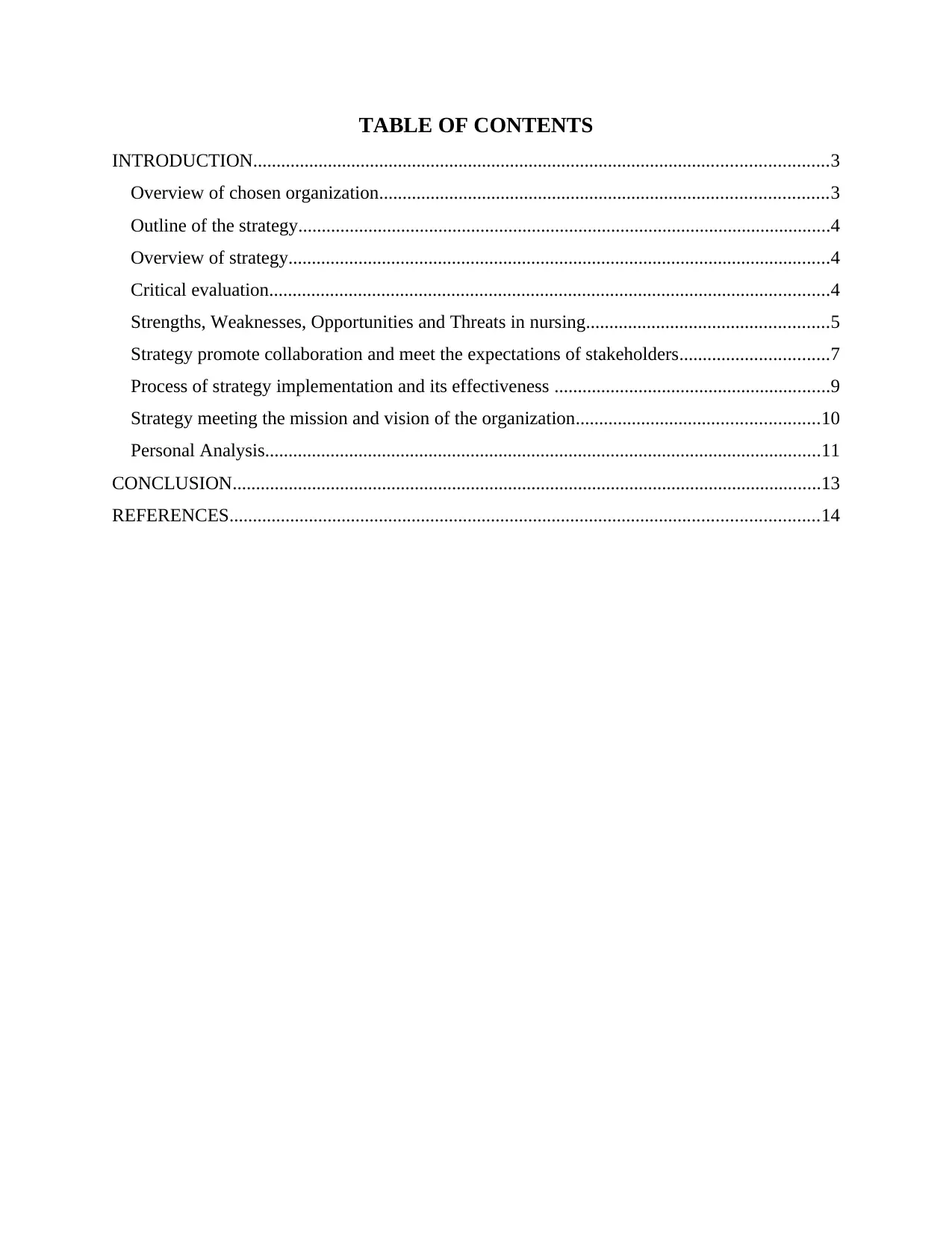
TABLE OF CONTENTS
INTRODUCTION...........................................................................................................................3
Overview of chosen organization................................................................................................3
Outline of the strategy..................................................................................................................4
Overview of strategy....................................................................................................................4
Critical evaluation........................................................................................................................4
Strengths, Weaknesses, Opportunities and Threats in nursing....................................................5
Strategy promote collaboration and meet the expectations of stakeholders................................7
Process of strategy implementation and its effectiveness ...........................................................9
Strategy meeting the mission and vision of the organization....................................................10
Personal Analysis.......................................................................................................................11
CONCLUSION..............................................................................................................................13
REFERENCES..............................................................................................................................14
INTRODUCTION...........................................................................................................................3
Overview of chosen organization................................................................................................3
Outline of the strategy..................................................................................................................4
Overview of strategy....................................................................................................................4
Critical evaluation........................................................................................................................4
Strengths, Weaknesses, Opportunities and Threats in nursing....................................................5
Strategy promote collaboration and meet the expectations of stakeholders................................7
Process of strategy implementation and its effectiveness ...........................................................9
Strategy meeting the mission and vision of the organization....................................................10
Personal Analysis.......................................................................................................................11
CONCLUSION..............................................................................................................................13
REFERENCES..............................................................................................................................14
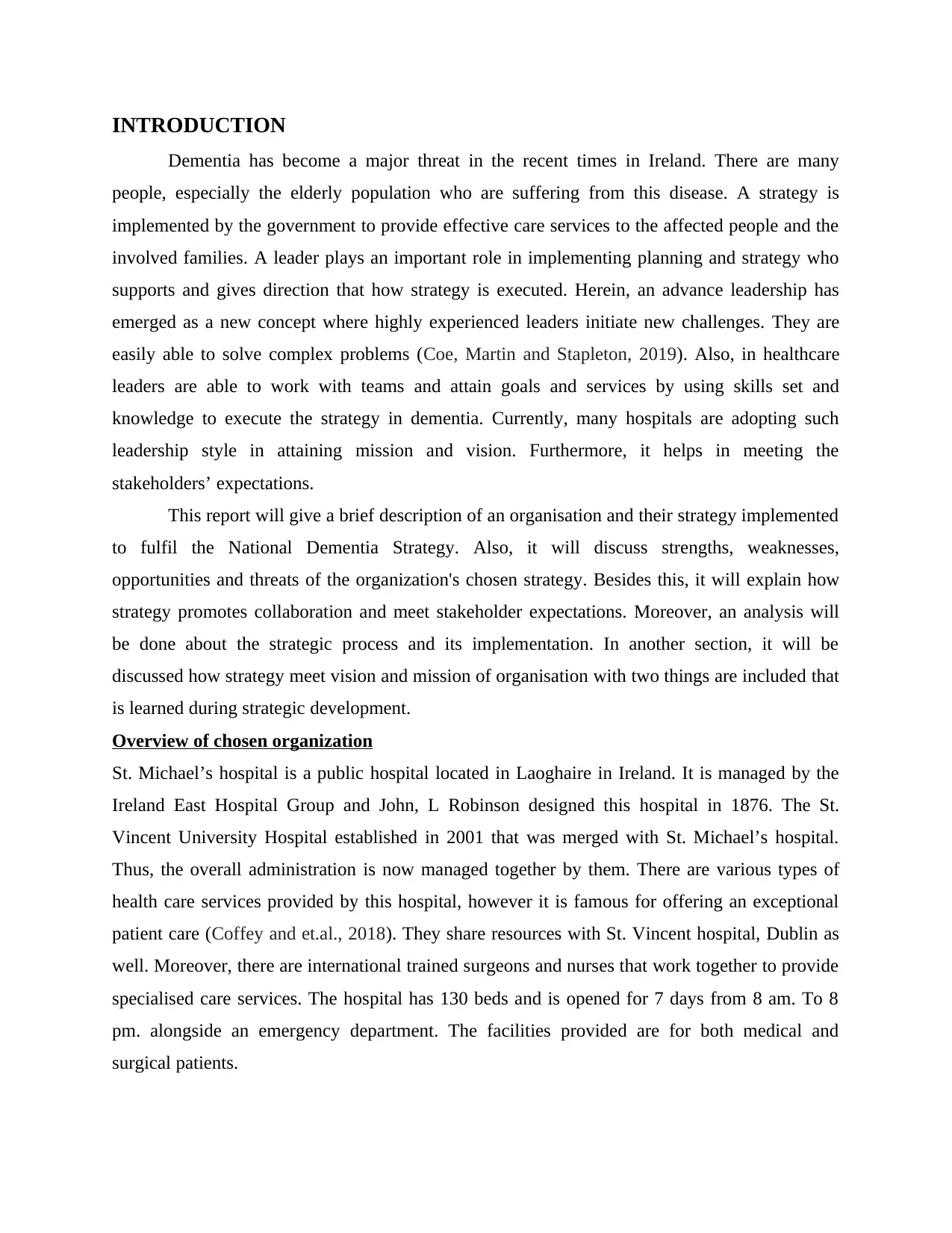
INTRODUCTION
Dementia has become a major threat in the recent times in Ireland. There are many
people, especially the elderly population who are suffering from this disease. A strategy is
implemented by the government to provide effective care services to the affected people and the
involved families. A leader plays an important role in implementing planning and strategy who
supports and gives direction that how strategy is executed. Herein, an advance leadership has
emerged as a new concept where highly experienced leaders initiate new challenges. They are
easily able to solve complex problems (Coe, Martin and Stapleton, 2019). Also, in healthcare
leaders are able to work with teams and attain goals and services by using skills set and
knowledge to execute the strategy in dementia. Currently, many hospitals are adopting such
leadership style in attaining mission and vision. Furthermore, it helps in meeting the
stakeholders’ expectations.
This report will give a brief description of an organisation and their strategy implemented
to fulfil the National Dementia Strategy. Also, it will discuss strengths, weaknesses,
opportunities and threats of the organization's chosen strategy. Besides this, it will explain how
strategy promotes collaboration and meet stakeholder expectations. Moreover, an analysis will
be done about the strategic process and its implementation. In another section, it will be
discussed how strategy meet vision and mission of organisation with two things are included that
is learned during strategic development.
Overview of chosen organization
St. Michael’s hospital is a public hospital located in Laoghaire in Ireland. It is managed by the
Ireland East Hospital Group and John, L Robinson designed this hospital in 1876. The St.
Vincent University Hospital established in 2001 that was merged with St. Michael’s hospital.
Thus, the overall administration is now managed together by them. There are various types of
health care services provided by this hospital, however it is famous for offering an exceptional
patient care (Coffey and et.al., 2018). They share resources with St. Vincent hospital, Dublin as
well. Moreover, there are international trained surgeons and nurses that work together to provide
specialised care services. The hospital has 130 beds and is opened for 7 days from 8 am. To 8
pm. alongside an emergency department. The facilities provided are for both medical and
surgical patients.
Dementia has become a major threat in the recent times in Ireland. There are many
people, especially the elderly population who are suffering from this disease. A strategy is
implemented by the government to provide effective care services to the affected people and the
involved families. A leader plays an important role in implementing planning and strategy who
supports and gives direction that how strategy is executed. Herein, an advance leadership has
emerged as a new concept where highly experienced leaders initiate new challenges. They are
easily able to solve complex problems (Coe, Martin and Stapleton, 2019). Also, in healthcare
leaders are able to work with teams and attain goals and services by using skills set and
knowledge to execute the strategy in dementia. Currently, many hospitals are adopting such
leadership style in attaining mission and vision. Furthermore, it helps in meeting the
stakeholders’ expectations.
This report will give a brief description of an organisation and their strategy implemented
to fulfil the National Dementia Strategy. Also, it will discuss strengths, weaknesses,
opportunities and threats of the organization's chosen strategy. Besides this, it will explain how
strategy promotes collaboration and meet stakeholder expectations. Moreover, an analysis will
be done about the strategic process and its implementation. In another section, it will be
discussed how strategy meet vision and mission of organisation with two things are included that
is learned during strategic development.
Overview of chosen organization
St. Michael’s hospital is a public hospital located in Laoghaire in Ireland. It is managed by the
Ireland East Hospital Group and John, L Robinson designed this hospital in 1876. The St.
Vincent University Hospital established in 2001 that was merged with St. Michael’s hospital.
Thus, the overall administration is now managed together by them. There are various types of
health care services provided by this hospital, however it is famous for offering an exceptional
patient care (Coffey and et.al., 2018). They share resources with St. Vincent hospital, Dublin as
well. Moreover, there are international trained surgeons and nurses that work together to provide
specialised care services. The hospital has 130 beds and is opened for 7 days from 8 am. To 8
pm. alongside an emergency department. The facilities provided are for both medical and
surgical patients.
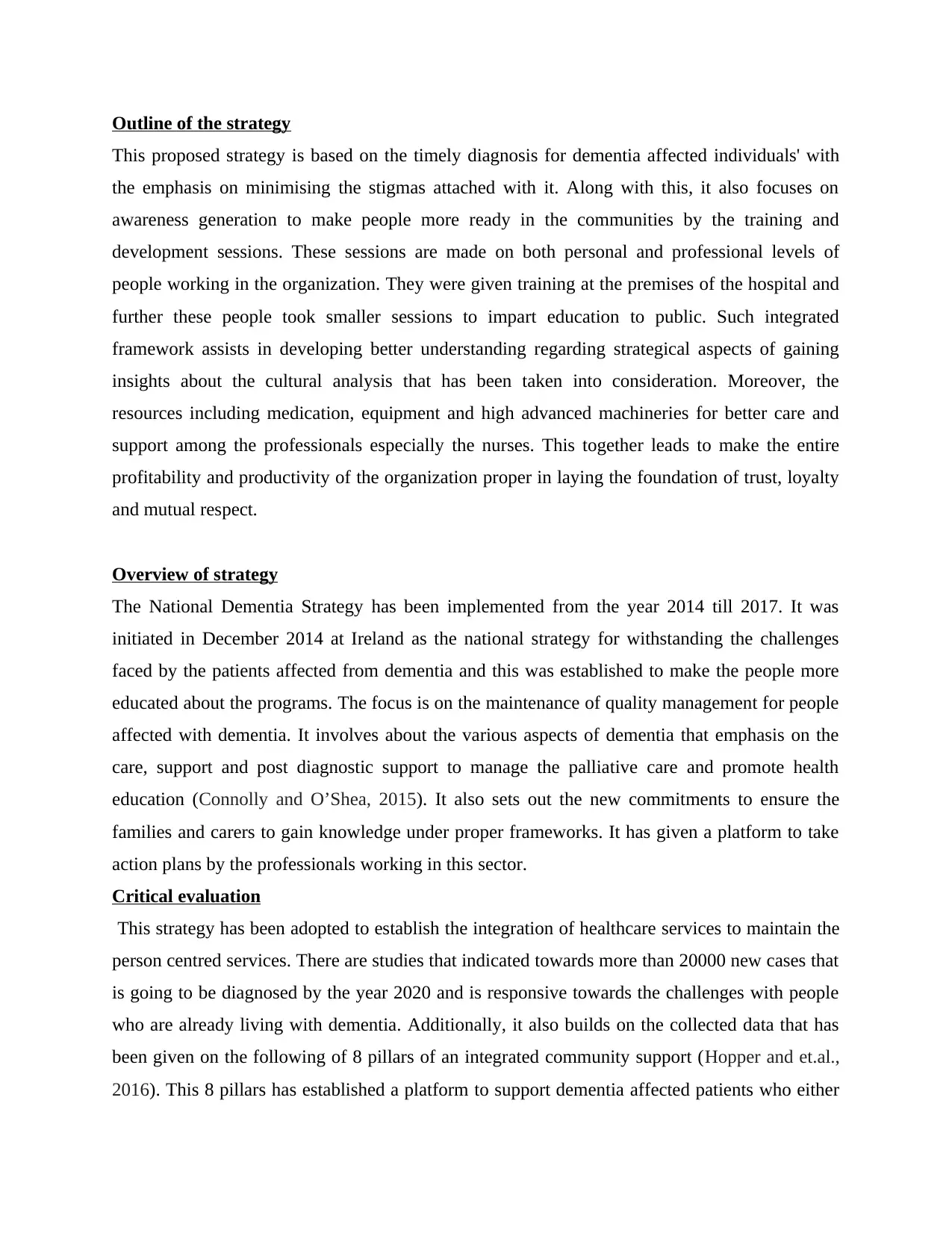
Outline of the strategy
This proposed strategy is based on the timely diagnosis for dementia affected individuals' with
the emphasis on minimising the stigmas attached with it. Along with this, it also focuses on
awareness generation to make people more ready in the communities by the training and
development sessions. These sessions are made on both personal and professional levels of
people working in the organization. They were given training at the premises of the hospital and
further these people took smaller sessions to impart education to public. Such integrated
framework assists in developing better understanding regarding strategical aspects of gaining
insights about the cultural analysis that has been taken into consideration. Moreover, the
resources including medication, equipment and high advanced machineries for better care and
support among the professionals especially the nurses. This together leads to make the entire
profitability and productivity of the organization proper in laying the foundation of trust, loyalty
and mutual respect.
Overview of strategy
The National Dementia Strategy has been implemented from the year 2014 till 2017. It was
initiated in December 2014 at Ireland as the national strategy for withstanding the challenges
faced by the patients affected from dementia and this was established to make the people more
educated about the programs. The focus is on the maintenance of quality management for people
affected with dementia. It involves about the various aspects of dementia that emphasis on the
care, support and post diagnostic support to manage the palliative care and promote health
education (Connolly and O’Shea, 2015). It also sets out the new commitments to ensure the
families and carers to gain knowledge under proper frameworks. It has given a platform to take
action plans by the professionals working in this sector.
Critical evaluation
This strategy has been adopted to establish the integration of healthcare services to maintain the
person centred services. There are studies that indicated towards more than 20000 new cases that
is going to be diagnosed by the year 2020 and is responsive towards the challenges with people
who are already living with dementia. Additionally, it also builds on the collected data that has
been given on the following of 8 pillars of an integrated community support (Hopper and et.al.,
2016). This 8 pillars has established a platform to support dementia affected patients who either
This proposed strategy is based on the timely diagnosis for dementia affected individuals' with
the emphasis on minimising the stigmas attached with it. Along with this, it also focuses on
awareness generation to make people more ready in the communities by the training and
development sessions. These sessions are made on both personal and professional levels of
people working in the organization. They were given training at the premises of the hospital and
further these people took smaller sessions to impart education to public. Such integrated
framework assists in developing better understanding regarding strategical aspects of gaining
insights about the cultural analysis that has been taken into consideration. Moreover, the
resources including medication, equipment and high advanced machineries for better care and
support among the professionals especially the nurses. This together leads to make the entire
profitability and productivity of the organization proper in laying the foundation of trust, loyalty
and mutual respect.
Overview of strategy
The National Dementia Strategy has been implemented from the year 2014 till 2017. It was
initiated in December 2014 at Ireland as the national strategy for withstanding the challenges
faced by the patients affected from dementia and this was established to make the people more
educated about the programs. The focus is on the maintenance of quality management for people
affected with dementia. It involves about the various aspects of dementia that emphasis on the
care, support and post diagnostic support to manage the palliative care and promote health
education (Connolly and O’Shea, 2015). It also sets out the new commitments to ensure the
families and carers to gain knowledge under proper frameworks. It has given a platform to take
action plans by the professionals working in this sector.
Critical evaluation
This strategy has been adopted to establish the integration of healthcare services to maintain the
person centred services. There are studies that indicated towards more than 20000 new cases that
is going to be diagnosed by the year 2020 and is responsive towards the challenges with people
who are already living with dementia. Additionally, it also builds on the collected data that has
been given on the following of 8 pillars of an integrated community support (Hopper and et.al.,
2016). This 8 pillars has established a platform to support dementia affected patients who either
Secure Best Marks with AI Grader
Need help grading? Try our AI Grader for instant feedback on your assignments.
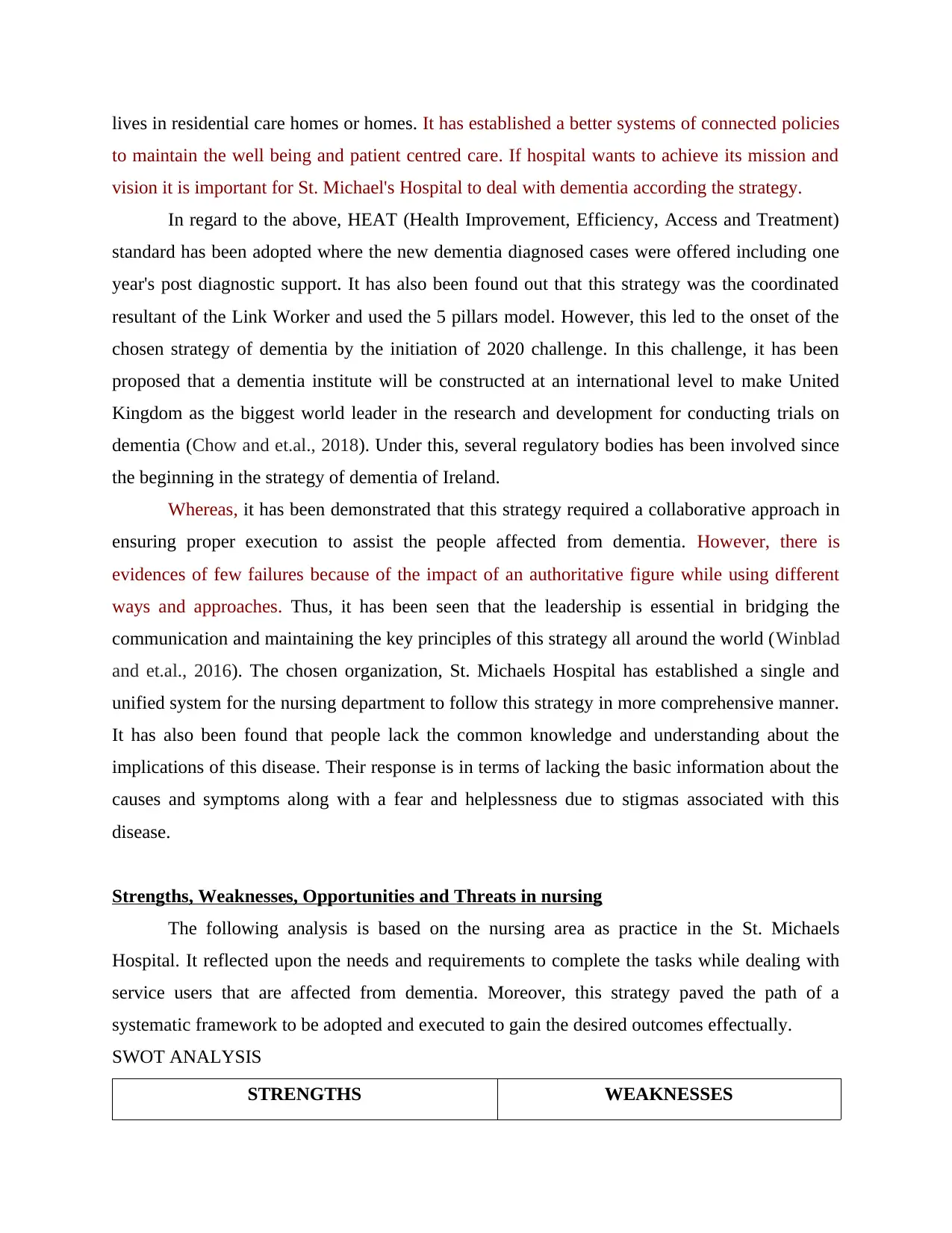
lives in residential care homes or homes. It has established a better systems of connected policies
to maintain the well being and patient centred care. If hospital wants to achieve its mission and
vision it is important for St. Michael's Hospital to deal with dementia according the strategy.
In regard to the above, HEAT (Health Improvement, Efficiency, Access and Treatment)
standard has been adopted where the new dementia diagnosed cases were offered including one
year's post diagnostic support. It has also been found out that this strategy was the coordinated
resultant of the Link Worker and used the 5 pillars model. However, this led to the onset of the
chosen strategy of dementia by the initiation of 2020 challenge. In this challenge, it has been
proposed that a dementia institute will be constructed at an international level to make United
Kingdom as the biggest world leader in the research and development for conducting trials on
dementia (Chow and et.al., 2018). Under this, several regulatory bodies has been involved since
the beginning in the strategy of dementia of Ireland.
Whereas, it has been demonstrated that this strategy required a collaborative approach in
ensuring proper execution to assist the people affected from dementia. However, there is
evidences of few failures because of the impact of an authoritative figure while using different
ways and approaches. Thus, it has been seen that the leadership is essential in bridging the
communication and maintaining the key principles of this strategy all around the world (Winblad
and et.al., 2016). The chosen organization, St. Michaels Hospital has established a single and
unified system for the nursing department to follow this strategy in more comprehensive manner.
It has also been found that people lack the common knowledge and understanding about the
implications of this disease. Their response is in terms of lacking the basic information about the
causes and symptoms along with a fear and helplessness due to stigmas associated with this
disease.
Strengths, Weaknesses, Opportunities and Threats in nursing
The following analysis is based on the nursing area as practice in the St. Michaels
Hospital. It reflected upon the needs and requirements to complete the tasks while dealing with
service users that are affected from dementia. Moreover, this strategy paved the path of a
systematic framework to be adopted and executed to gain the desired outcomes effectually.
SWOT ANALYSIS
STRENGTHS WEAKNESSES
to maintain the well being and patient centred care. If hospital wants to achieve its mission and
vision it is important for St. Michael's Hospital to deal with dementia according the strategy.
In regard to the above, HEAT (Health Improvement, Efficiency, Access and Treatment)
standard has been adopted where the new dementia diagnosed cases were offered including one
year's post diagnostic support. It has also been found out that this strategy was the coordinated
resultant of the Link Worker and used the 5 pillars model. However, this led to the onset of the
chosen strategy of dementia by the initiation of 2020 challenge. In this challenge, it has been
proposed that a dementia institute will be constructed at an international level to make United
Kingdom as the biggest world leader in the research and development for conducting trials on
dementia (Chow and et.al., 2018). Under this, several regulatory bodies has been involved since
the beginning in the strategy of dementia of Ireland.
Whereas, it has been demonstrated that this strategy required a collaborative approach in
ensuring proper execution to assist the people affected from dementia. However, there is
evidences of few failures because of the impact of an authoritative figure while using different
ways and approaches. Thus, it has been seen that the leadership is essential in bridging the
communication and maintaining the key principles of this strategy all around the world (Winblad
and et.al., 2016). The chosen organization, St. Michaels Hospital has established a single and
unified system for the nursing department to follow this strategy in more comprehensive manner.
It has also been found that people lack the common knowledge and understanding about the
implications of this disease. Their response is in terms of lacking the basic information about the
causes and symptoms along with a fear and helplessness due to stigmas associated with this
disease.
Strengths, Weaknesses, Opportunities and Threats in nursing
The following analysis is based on the nursing area as practice in the St. Michaels
Hospital. It reflected upon the needs and requirements to complete the tasks while dealing with
service users that are affected from dementia. Moreover, this strategy paved the path of a
systematic framework to be adopted and executed to gain the desired outcomes effectually.
SWOT ANALYSIS
STRENGTHS WEAKNESSES
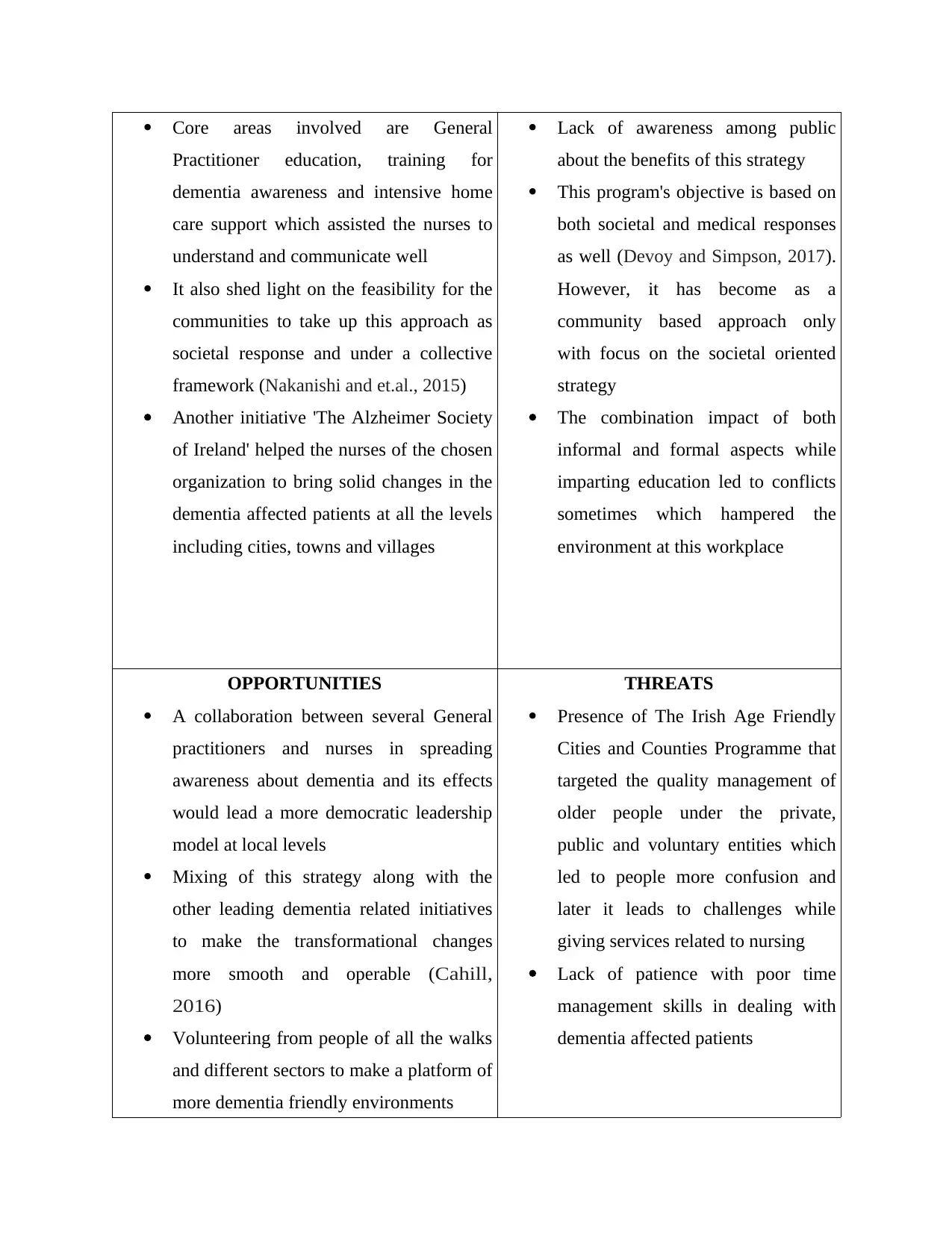
Core areas involved are General
Practitioner education, training for
dementia awareness and intensive home
care support which assisted the nurses to
understand and communicate well
It also shed light on the feasibility for the
communities to take up this approach as
societal response and under a collective
framework (Nakanishi and et.al., 2015)
Another initiative 'The Alzheimer Society
of Ireland' helped the nurses of the chosen
organization to bring solid changes in the
dementia affected patients at all the levels
including cities, towns and villages
Lack of awareness among public
about the benefits of this strategy
This program's objective is based on
both societal and medical responses
as well (Devoy and Simpson, 2017).
However, it has become as a
community based approach only
with focus on the societal oriented
strategy
The combination impact of both
informal and formal aspects while
imparting education led to conflicts
sometimes which hampered the
environment at this workplace
OPPORTUNITIES
A collaboration between several General
practitioners and nurses in spreading
awareness about dementia and its effects
would lead a more democratic leadership
model at local levels
Mixing of this strategy along with the
other leading dementia related initiatives
to make the transformational changes
more smooth and operable ( Cahill,
2016)
Volunteering from people of all the walks
and different sectors to make a platform of
more dementia friendly environments
THREATS
Presence of The Irish Age Friendly
Cities and Counties Programme that
targeted the quality management of
older people under the private,
public and voluntary entities which
led to people more confusion and
later it leads to challenges while
giving services related to nursing
Lack of patience with poor time
management skills in dealing with
dementia affected patients
Practitioner education, training for
dementia awareness and intensive home
care support which assisted the nurses to
understand and communicate well
It also shed light on the feasibility for the
communities to take up this approach as
societal response and under a collective
framework (Nakanishi and et.al., 2015)
Another initiative 'The Alzheimer Society
of Ireland' helped the nurses of the chosen
organization to bring solid changes in the
dementia affected patients at all the levels
including cities, towns and villages
Lack of awareness among public
about the benefits of this strategy
This program's objective is based on
both societal and medical responses
as well (Devoy and Simpson, 2017).
However, it has become as a
community based approach only
with focus on the societal oriented
strategy
The combination impact of both
informal and formal aspects while
imparting education led to conflicts
sometimes which hampered the
environment at this workplace
OPPORTUNITIES
A collaboration between several General
practitioners and nurses in spreading
awareness about dementia and its effects
would lead a more democratic leadership
model at local levels
Mixing of this strategy along with the
other leading dementia related initiatives
to make the transformational changes
more smooth and operable ( Cahill,
2016)
Volunteering from people of all the walks
and different sectors to make a platform of
more dementia friendly environments
THREATS
Presence of The Irish Age Friendly
Cities and Counties Programme that
targeted the quality management of
older people under the private,
public and voluntary entities which
led to people more confusion and
later it leads to challenges while
giving services related to nursing
Lack of patience with poor time
management skills in dealing with
dementia affected patients
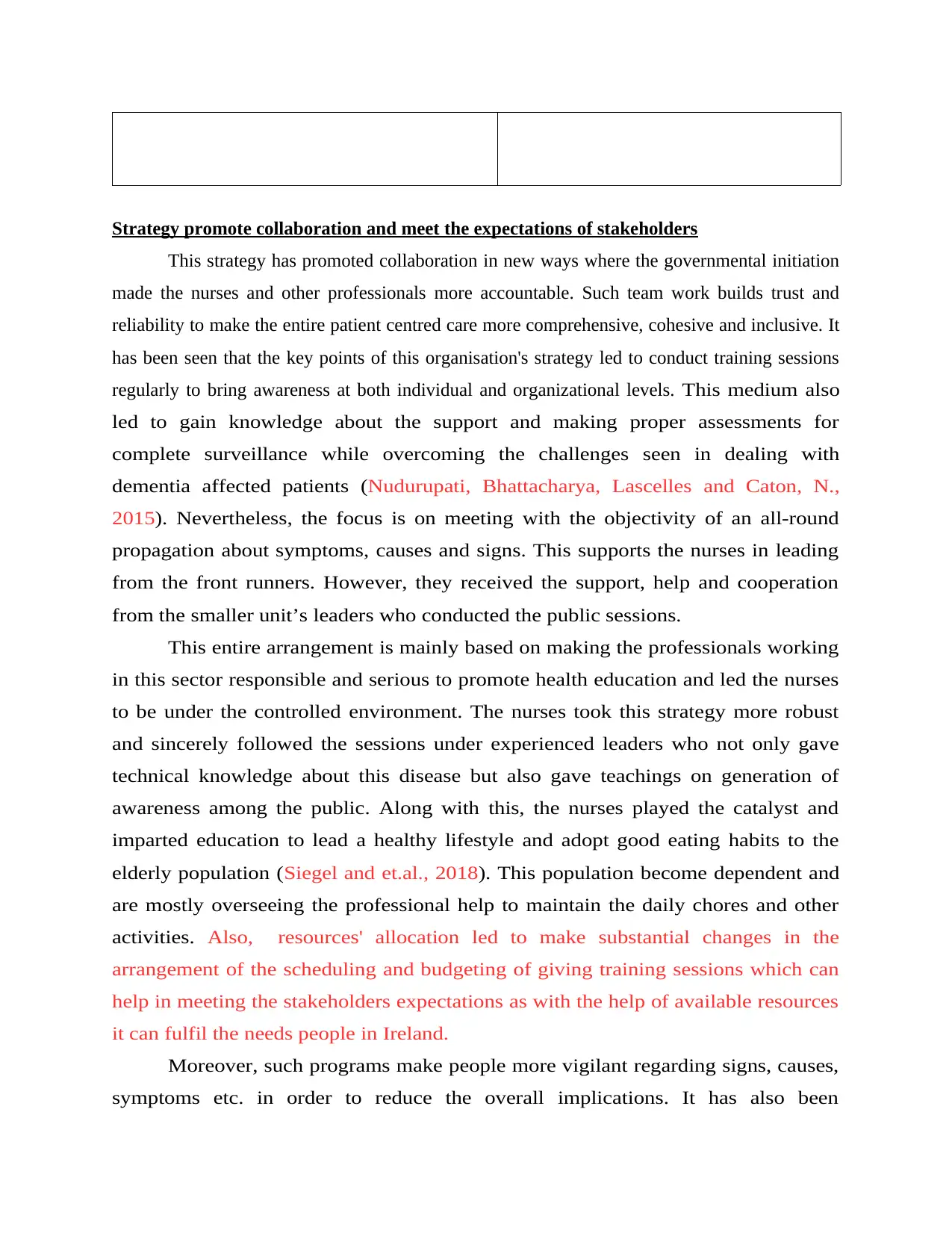
Strategy promote collaboration and meet the expectations of stakeholders
This strategy has promoted collaboration in new ways where the governmental initiation
made the nurses and other professionals more accountable. Such team work builds trust and
reliability to make the entire patient centred care more comprehensive, cohesive and inclusive. It
has been seen that the key points of this organisation's strategy led to conduct training sessions
regularly to bring awareness at both individual and organizational levels. This medium also
led to gain knowledge about the support and making proper assessments for
complete surveillance while overcoming the challenges seen in dealing with
dementia affected patients (Nudurupati, Bhattacharya, Lascelles and Caton, N.,
2015). Nevertheless, the focus is on meeting with the objectivity of an all-round
propagation about symptoms, causes and signs. This supports the nurses in leading
from the front runners. However, they received the support, help and cooperation
from the smaller unit’s leaders who conducted the public sessions.
This entire arrangement is mainly based on making the professionals working
in this sector responsible and serious to promote health education and led the nurses
to be under the controlled environment. The nurses took this strategy more robust
and sincerely followed the sessions under experienced leaders who not only gave
technical knowledge about this disease but also gave teachings on generation of
awareness among the public. Along with this, the nurses played the catalyst and
imparted education to lead a healthy lifestyle and adopt good eating habits to the
elderly population (Siegel and et.al., 2018). This population become dependent and
are mostly overseeing the professional help to maintain the daily chores and other
activities. Also, resources' allocation led to make substantial changes in the
arrangement of the scheduling and budgeting of giving training sessions which can
help in meeting the stakeholders expectations as with the help of available resources
it can fulfil the needs people in Ireland.
Moreover, such programs make people more vigilant regarding signs, causes,
symptoms etc. in order to reduce the overall implications. It has also been
This strategy has promoted collaboration in new ways where the governmental initiation
made the nurses and other professionals more accountable. Such team work builds trust and
reliability to make the entire patient centred care more comprehensive, cohesive and inclusive. It
has been seen that the key points of this organisation's strategy led to conduct training sessions
regularly to bring awareness at both individual and organizational levels. This medium also
led to gain knowledge about the support and making proper assessments for
complete surveillance while overcoming the challenges seen in dealing with
dementia affected patients (Nudurupati, Bhattacharya, Lascelles and Caton, N.,
2015). Nevertheless, the focus is on meeting with the objectivity of an all-round
propagation about symptoms, causes and signs. This supports the nurses in leading
from the front runners. However, they received the support, help and cooperation
from the smaller unit’s leaders who conducted the public sessions.
This entire arrangement is mainly based on making the professionals working
in this sector responsible and serious to promote health education and led the nurses
to be under the controlled environment. The nurses took this strategy more robust
and sincerely followed the sessions under experienced leaders who not only gave
technical knowledge about this disease but also gave teachings on generation of
awareness among the public. Along with this, the nurses played the catalyst and
imparted education to lead a healthy lifestyle and adopt good eating habits to the
elderly population (Siegel and et.al., 2018). This population become dependent and
are mostly overseeing the professional help to maintain the daily chores and other
activities. Also, resources' allocation led to make substantial changes in the
arrangement of the scheduling and budgeting of giving training sessions which can
help in meeting the stakeholders expectations as with the help of available resources
it can fulfil the needs people in Ireland.
Moreover, such programs make people more vigilant regarding signs, causes,
symptoms etc. in order to reduce the overall implications. It has also been
Paraphrase This Document
Need a fresh take? Get an instant paraphrase of this document with our AI Paraphraser
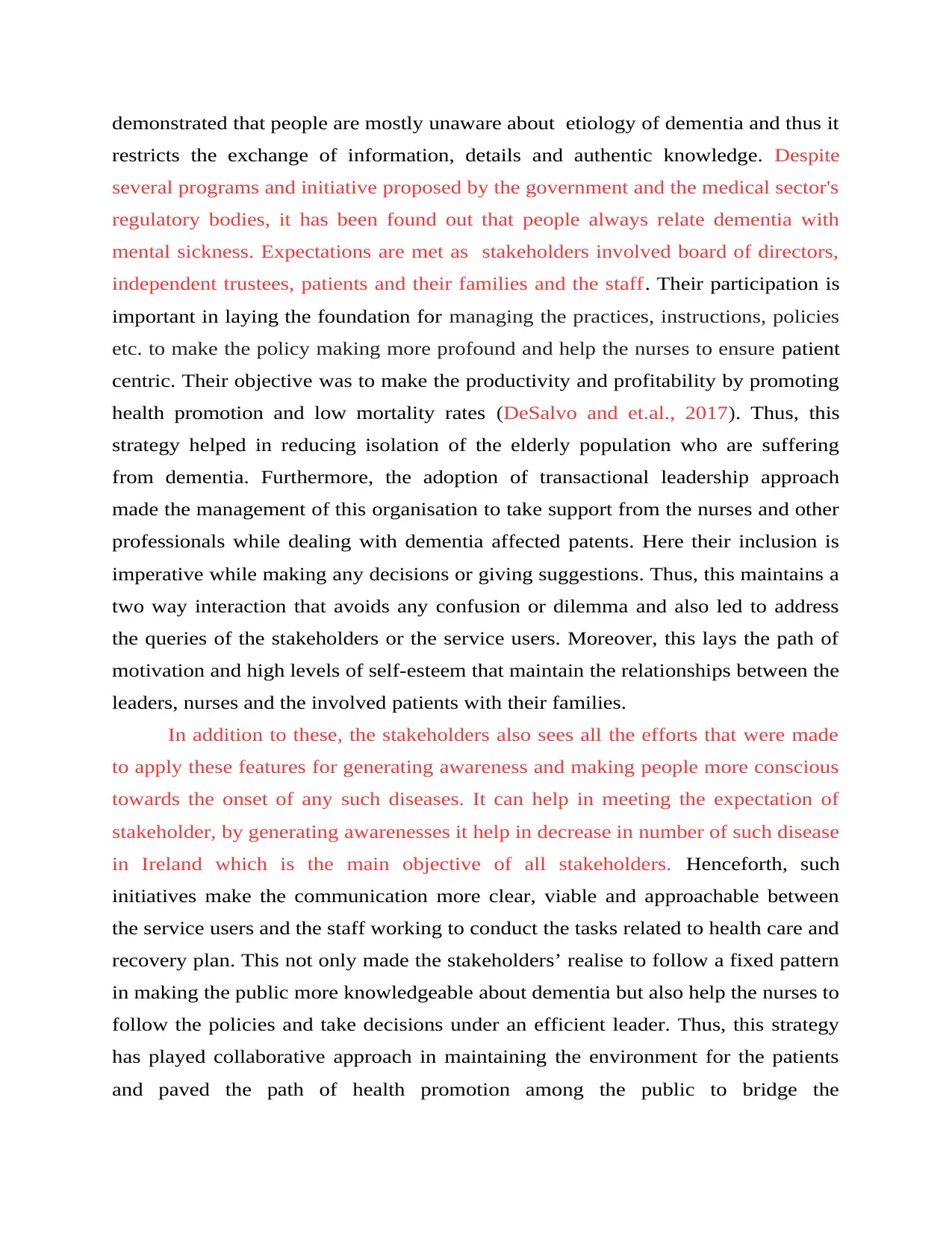
demonstrated that people are mostly unaware about etiology of dementia and thus it
restricts the exchange of information, details and authentic knowledge. Despite
several programs and initiative proposed by the government and the medical sector's
regulatory bodies, it has been found out that people always relate dementia with
mental sickness. Expectations are met as stakeholders involved board of directors,
independent trustees, patients and their families and the staff. Their participation is
important in laying the foundation for managing the practices, instructions, policies
etc. to make the policy making more profound and help the nurses to ensure patient
centric. Their objective was to make the productivity and profitability by promoting
health promotion and low mortality rates (DeSalvo and et.al., 2017). Thus, this
strategy helped in reducing isolation of the elderly population who are suffering
from dementia. Furthermore, the adoption of transactional leadership approach
made the management of this organisation to take support from the nurses and other
professionals while dealing with dementia affected patents. Here their inclusion is
imperative while making any decisions or giving suggestions. Thus, this maintains a
two way interaction that avoids any confusion or dilemma and also led to address
the queries of the stakeholders or the service users. Moreover, this lays the path of
motivation and high levels of self-esteem that maintain the relationships between the
leaders, nurses and the involved patients with their families.
In addition to these, the stakeholders also sees all the efforts that were made
to apply these features for generating awareness and making people more conscious
towards the onset of any such diseases. It can help in meeting the expectation of
stakeholder, by generating awarenesses it help in decrease in number of such disease
in Ireland which is the main objective of all stakeholders. Henceforth, such
initiatives make the communication more clear, viable and approachable between
the service users and the staff working to conduct the tasks related to health care and
recovery plan. This not only made the stakeholders’ realise to follow a fixed pattern
in making the public more knowledgeable about dementia but also help the nurses to
follow the policies and take decisions under an efficient leader. Thus, this strategy
has played collaborative approach in maintaining the environment for the patients
and paved the path of health promotion among the public to bridge the
restricts the exchange of information, details and authentic knowledge. Despite
several programs and initiative proposed by the government and the medical sector's
regulatory bodies, it has been found out that people always relate dementia with
mental sickness. Expectations are met as stakeholders involved board of directors,
independent trustees, patients and their families and the staff. Their participation is
important in laying the foundation for managing the practices, instructions, policies
etc. to make the policy making more profound and help the nurses to ensure patient
centric. Their objective was to make the productivity and profitability by promoting
health promotion and low mortality rates (DeSalvo and et.al., 2017). Thus, this
strategy helped in reducing isolation of the elderly population who are suffering
from dementia. Furthermore, the adoption of transactional leadership approach
made the management of this organisation to take support from the nurses and other
professionals while dealing with dementia affected patents. Here their inclusion is
imperative while making any decisions or giving suggestions. Thus, this maintains a
two way interaction that avoids any confusion or dilemma and also led to address
the queries of the stakeholders or the service users. Moreover, this lays the path of
motivation and high levels of self-esteem that maintain the relationships between the
leaders, nurses and the involved patients with their families.
In addition to these, the stakeholders also sees all the efforts that were made
to apply these features for generating awareness and making people more conscious
towards the onset of any such diseases. It can help in meeting the expectation of
stakeholder, by generating awarenesses it help in decrease in number of such disease
in Ireland which is the main objective of all stakeholders. Henceforth, such
initiatives make the communication more clear, viable and approachable between
the service users and the staff working to conduct the tasks related to health care and
recovery plan. This not only made the stakeholders’ realise to follow a fixed pattern
in making the public more knowledgeable about dementia but also help the nurses to
follow the policies and take decisions under an efficient leader. Thus, this strategy
has played collaborative approach in maintaining the environment for the patients
and paved the path of health promotion among the public to bridge the
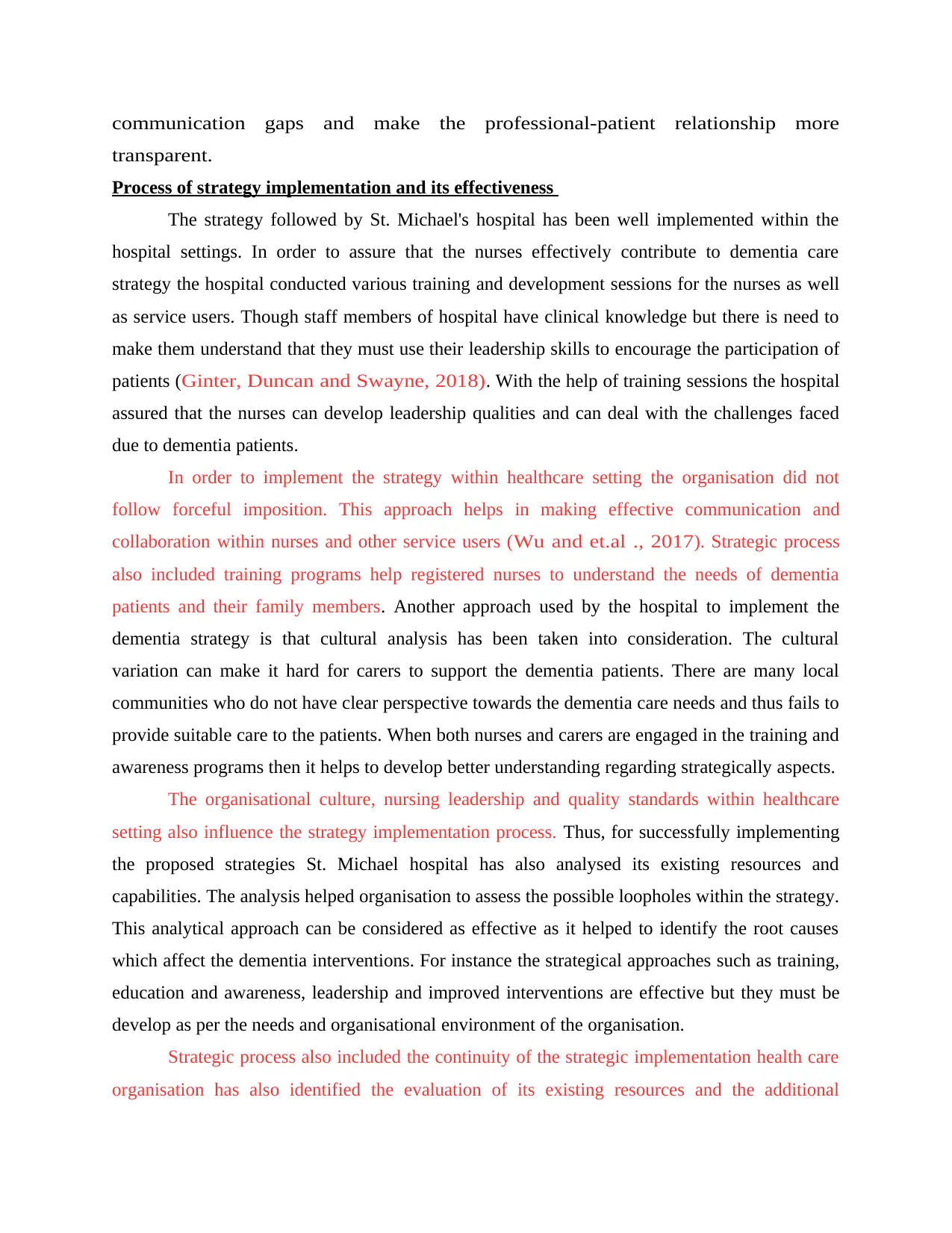
communication gaps and make the professional-patient relationship more
transparent.
Process of strategy implementation and its effectiveness
The strategy followed by St. Michael's hospital has been well implemented within the
hospital settings. In order to assure that the nurses effectively contribute to dementia care
strategy the hospital conducted various training and development sessions for the nurses as well
as service users. Though staff members of hospital have clinical knowledge but there is need to
make them understand that they must use their leadership skills to encourage the participation of
patients ( Ginter, Duncan and Swayne, 2018). With the help of training sessions the hospital
assured that the nurses can develop leadership qualities and can deal with the challenges faced
due to dementia patients.
In order to implement the strategy within healthcare setting the organisation did not
follow forceful imposition. This approach helps in making effective communication and
collaboration within nurses and other service users ( Wu and et.al ., 2017). Strategic process
also included training programs help registered nurses to understand the needs of dementia
patients and their family members. Another approach used by the hospital to implement the
dementia strategy is that cultural analysis has been taken into consideration. The cultural
variation can make it hard for carers to support the dementia patients. There are many local
communities who do not have clear perspective towards the dementia care needs and thus fails to
provide suitable care to the patients. When both nurses and carers are engaged in the training and
awareness programs then it helps to develop better understanding regarding strategically aspects.
The organisational culture, nursing leadership and quality standards within healthcare
setting also influence the strategy implementation process. Thus, for successfully implementing
the proposed strategies St. Michael hospital has also analysed its existing resources and
capabilities. The analysis helped organisation to assess the possible loopholes within the strategy.
This analytical approach can be considered as effective as it helped to identify the root causes
which affect the dementia interventions. For instance the strategical approaches such as training,
education and awareness, leadership and improved interventions are effective but they must be
develop as per the needs and organisational environment of the organisation.
Strategic process also included the continuity of the strategic implementation health care
organisation has also identified the evaluation of its existing resources and the additional
transparent.
Process of strategy implementation and its effectiveness
The strategy followed by St. Michael's hospital has been well implemented within the
hospital settings. In order to assure that the nurses effectively contribute to dementia care
strategy the hospital conducted various training and development sessions for the nurses as well
as service users. Though staff members of hospital have clinical knowledge but there is need to
make them understand that they must use their leadership skills to encourage the participation of
patients ( Ginter, Duncan and Swayne, 2018). With the help of training sessions the hospital
assured that the nurses can develop leadership qualities and can deal with the challenges faced
due to dementia patients.
In order to implement the strategy within healthcare setting the organisation did not
follow forceful imposition. This approach helps in making effective communication and
collaboration within nurses and other service users ( Wu and et.al ., 2017). Strategic process
also included training programs help registered nurses to understand the needs of dementia
patients and their family members. Another approach used by the hospital to implement the
dementia strategy is that cultural analysis has been taken into consideration. The cultural
variation can make it hard for carers to support the dementia patients. There are many local
communities who do not have clear perspective towards the dementia care needs and thus fails to
provide suitable care to the patients. When both nurses and carers are engaged in the training and
awareness programs then it helps to develop better understanding regarding strategically aspects.
The organisational culture, nursing leadership and quality standards within healthcare
setting also influence the strategy implementation process. Thus, for successfully implementing
the proposed strategies St. Michael hospital has also analysed its existing resources and
capabilities. The analysis helped organisation to assess the possible loopholes within the strategy.
This analytical approach can be considered as effective as it helped to identify the root causes
which affect the dementia interventions. For instance the strategical approaches such as training,
education and awareness, leadership and improved interventions are effective but they must be
develop as per the needs and organisational environment of the organisation.
Strategic process also included the continuity of the strategic implementation health care
organisation has also identified the evaluation of its existing resources and the additional
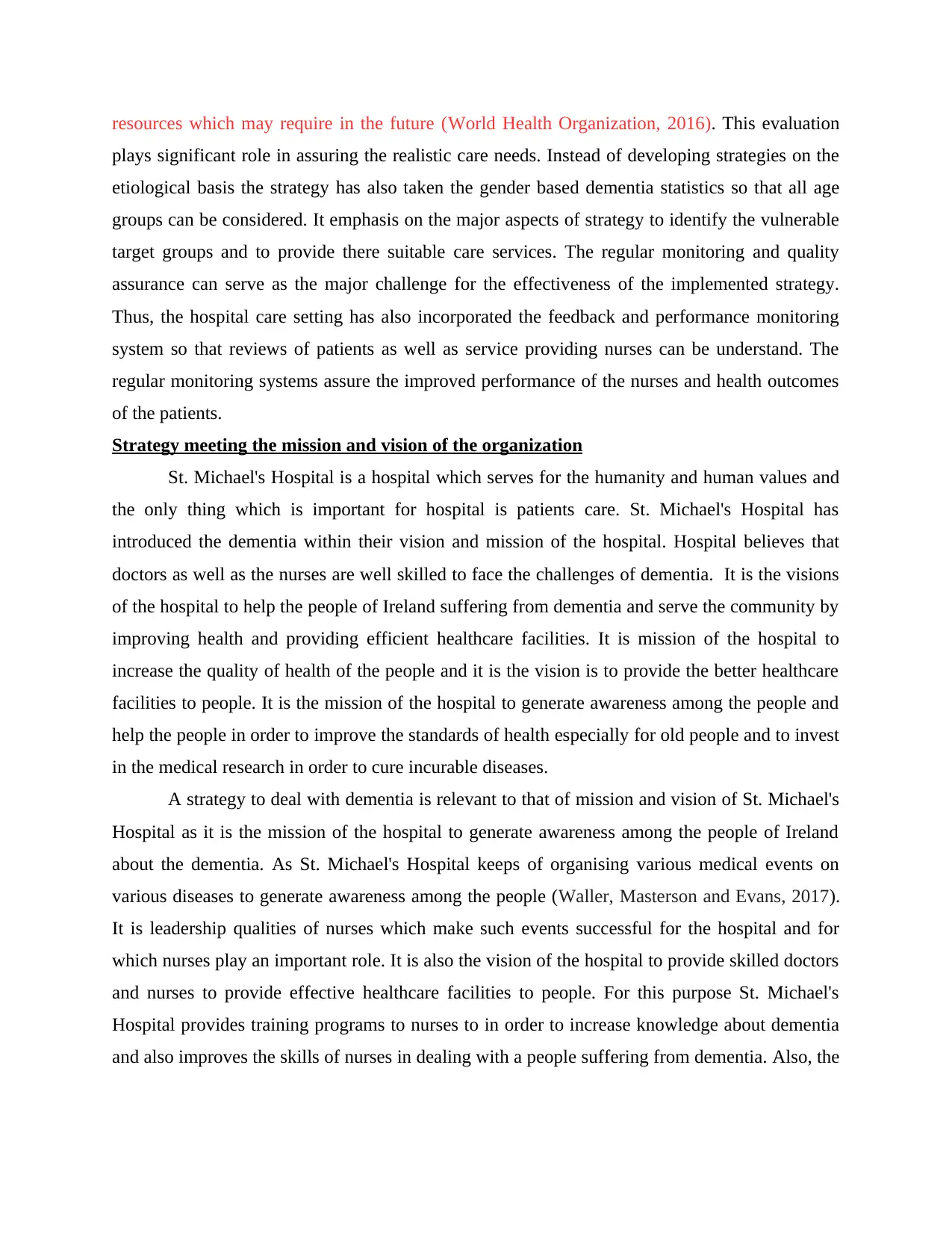
resources which may require in the future (World Health Organization, 2016). This evaluation
plays significant role in assuring the realistic care needs. Instead of developing strategies on the
etiological basis the strategy has also taken the gender based dementia statistics so that all age
groups can be considered. It emphasis on the major aspects of strategy to identify the vulnerable
target groups and to provide there suitable care services. The regular monitoring and quality
assurance can serve as the major challenge for the effectiveness of the implemented strategy.
Thus, the hospital care setting has also incorporated the feedback and performance monitoring
system so that reviews of patients as well as service providing nurses can be understand. The
regular monitoring systems assure the improved performance of the nurses and health outcomes
of the patients.
Strategy meeting the mission and vision of the organization
St. Michael's Hospital is a hospital which serves for the humanity and human values and
the only thing which is important for hospital is patients care. St. Michael's Hospital has
introduced the dementia within their vision and mission of the hospital. Hospital believes that
doctors as well as the nurses are well skilled to face the challenges of dementia. It is the visions
of the hospital to help the people of Ireland suffering from dementia and serve the community by
improving health and providing efficient healthcare facilities. It is mission of the hospital to
increase the quality of health of the people and it is the vision is to provide the better healthcare
facilities to people. It is the mission of the hospital to generate awareness among the people and
help the people in order to improve the standards of health especially for old people and to invest
in the medical research in order to cure incurable diseases.
A strategy to deal with dementia is relevant to that of mission and vision of St. Michael's
Hospital as it is the mission of the hospital to generate awareness among the people of Ireland
about the dementia. As St. Michael's Hospital keeps of organising various medical events on
various diseases to generate awareness among the people (Waller, Masterson and Evans, 2017).
It is leadership qualities of nurses which make such events successful for the hospital and for
which nurses play an important role. It is also the vision of the hospital to provide skilled doctors
and nurses to provide effective healthcare facilities to people. For this purpose St. Michael's
Hospital provides training programs to nurses to in order to increase knowledge about dementia
and also improves the skills of nurses in dealing with a people suffering from dementia. Also, the
plays significant role in assuring the realistic care needs. Instead of developing strategies on the
etiological basis the strategy has also taken the gender based dementia statistics so that all age
groups can be considered. It emphasis on the major aspects of strategy to identify the vulnerable
target groups and to provide there suitable care services. The regular monitoring and quality
assurance can serve as the major challenge for the effectiveness of the implemented strategy.
Thus, the hospital care setting has also incorporated the feedback and performance monitoring
system so that reviews of patients as well as service providing nurses can be understand. The
regular monitoring systems assure the improved performance of the nurses and health outcomes
of the patients.
Strategy meeting the mission and vision of the organization
St. Michael's Hospital is a hospital which serves for the humanity and human values and
the only thing which is important for hospital is patients care. St. Michael's Hospital has
introduced the dementia within their vision and mission of the hospital. Hospital believes that
doctors as well as the nurses are well skilled to face the challenges of dementia. It is the visions
of the hospital to help the people of Ireland suffering from dementia and serve the community by
improving health and providing efficient healthcare facilities. It is mission of the hospital to
increase the quality of health of the people and it is the vision is to provide the better healthcare
facilities to people. It is the mission of the hospital to generate awareness among the people and
help the people in order to improve the standards of health especially for old people and to invest
in the medical research in order to cure incurable diseases.
A strategy to deal with dementia is relevant to that of mission and vision of St. Michael's
Hospital as it is the mission of the hospital to generate awareness among the people of Ireland
about the dementia. As St. Michael's Hospital keeps of organising various medical events on
various diseases to generate awareness among the people (Waller, Masterson and Evans, 2017).
It is leadership qualities of nurses which make such events successful for the hospital and for
which nurses play an important role. It is also the vision of the hospital to provide skilled doctors
and nurses to provide effective healthcare facilities to people. For this purpose St. Michael's
Hospital provides training programs to nurses to in order to increase knowledge about dementia
and also improves the skills of nurses in dealing with a people suffering from dementia. Also, the
Secure Best Marks with AI Grader
Need help grading? Try our AI Grader for instant feedback on your assignments.
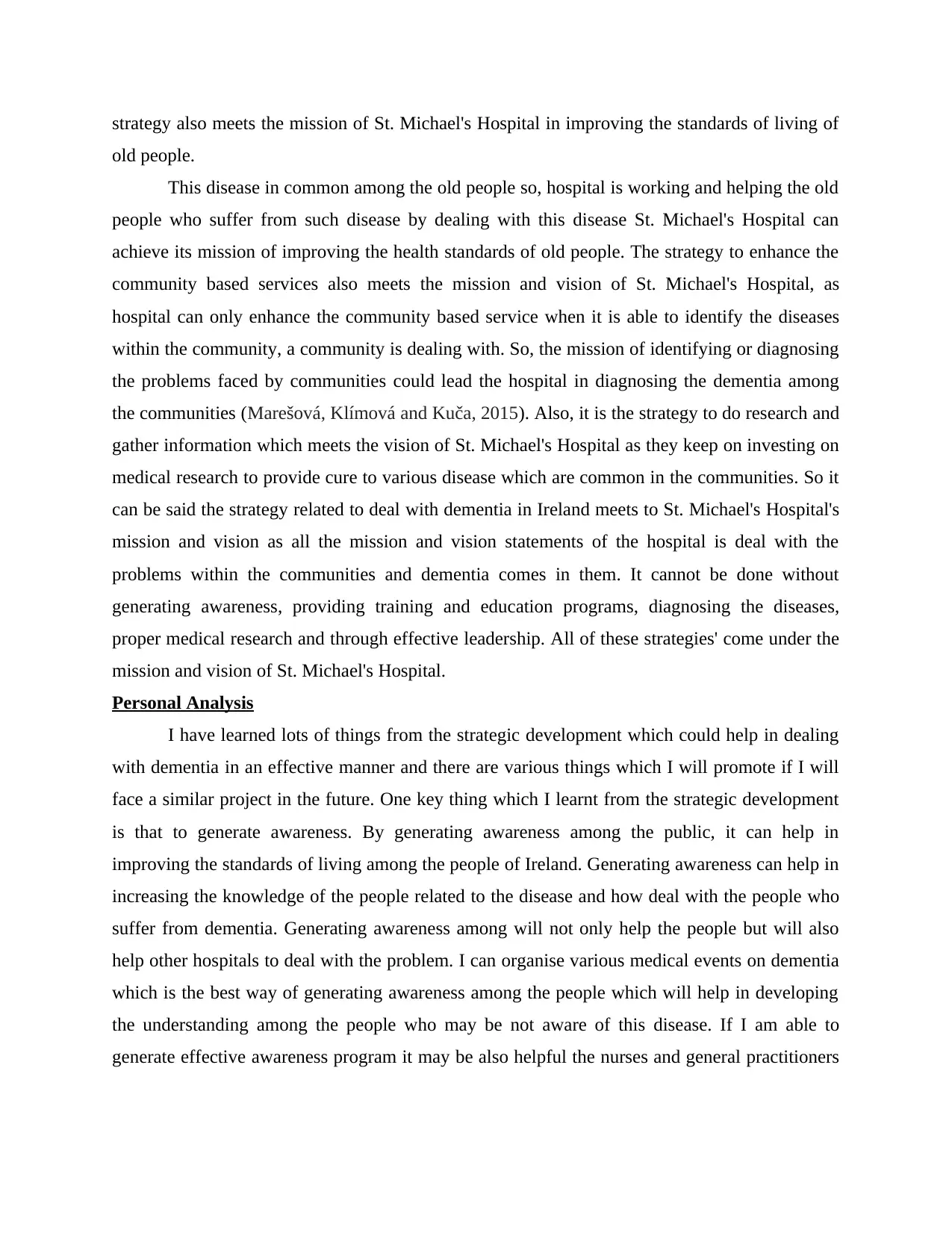
strategy also meets the mission of St. Michael's Hospital in improving the standards of living of
old people.
This disease in common among the old people so, hospital is working and helping the old
people who suffer from such disease by dealing with this disease St. Michael's Hospital can
achieve its mission of improving the health standards of old people. The strategy to enhance the
community based services also meets the mission and vision of St. Michael's Hospital, as
hospital can only enhance the community based service when it is able to identify the diseases
within the community, a community is dealing with. So, the mission of identifying or diagnosing
the problems faced by communities could lead the hospital in diagnosing the dementia among
the communities (Marešová, Klímová and Kuča, 2015). Also, it is the strategy to do research and
gather information which meets the vision of St. Michael's Hospital as they keep on investing on
medical research to provide cure to various disease which are common in the communities. So it
can be said the strategy related to deal with dementia in Ireland meets to St. Michael's Hospital's
mission and vision as all the mission and vision statements of the hospital is deal with the
problems within the communities and dementia comes in them. It cannot be done without
generating awareness, providing training and education programs, diagnosing the diseases,
proper medical research and through effective leadership. All of these strategies' come under the
mission and vision of St. Michael's Hospital.
Personal Analysis
I have learned lots of things from the strategic development which could help in dealing
with dementia in an effective manner and there are various things which I will promote if I will
face a similar project in the future. One key thing which I learnt from the strategic development
is that to generate awareness. By generating awareness among the public, it can help in
improving the standards of living among the people of Ireland. Generating awareness can help in
increasing the knowledge of the people related to the disease and how deal with the people who
suffer from dementia. Generating awareness among will not only help the people but will also
help other hospitals to deal with the problem. I can organise various medical events on dementia
which is the best way of generating awareness among the people which will help in developing
the understanding among the people who may be not aware of this disease. If I am able to
generate effective awareness program it may be also helpful the nurses and general practitioners
old people.
This disease in common among the old people so, hospital is working and helping the old
people who suffer from such disease by dealing with this disease St. Michael's Hospital can
achieve its mission of improving the health standards of old people. The strategy to enhance the
community based services also meets the mission and vision of St. Michael's Hospital, as
hospital can only enhance the community based service when it is able to identify the diseases
within the community, a community is dealing with. So, the mission of identifying or diagnosing
the problems faced by communities could lead the hospital in diagnosing the dementia among
the communities (Marešová, Klímová and Kuča, 2015). Also, it is the strategy to do research and
gather information which meets the vision of St. Michael's Hospital as they keep on investing on
medical research to provide cure to various disease which are common in the communities. So it
can be said the strategy related to deal with dementia in Ireland meets to St. Michael's Hospital's
mission and vision as all the mission and vision statements of the hospital is deal with the
problems within the communities and dementia comes in them. It cannot be done without
generating awareness, providing training and education programs, diagnosing the diseases,
proper medical research and through effective leadership. All of these strategies' come under the
mission and vision of St. Michael's Hospital.
Personal Analysis
I have learned lots of things from the strategic development which could help in dealing
with dementia in an effective manner and there are various things which I will promote if I will
face a similar project in the future. One key thing which I learnt from the strategic development
is that to generate awareness. By generating awareness among the public, it can help in
improving the standards of living among the people of Ireland. Generating awareness can help in
increasing the knowledge of the people related to the disease and how deal with the people who
suffer from dementia. Generating awareness among will not only help the people but will also
help other hospitals to deal with the problem. I can organise various medical events on dementia
which is the best way of generating awareness among the people which will help in developing
the understanding among the people who may be not aware of this disease. If I am able to
generate effective awareness program it may be also helpful the nurses and general practitioners
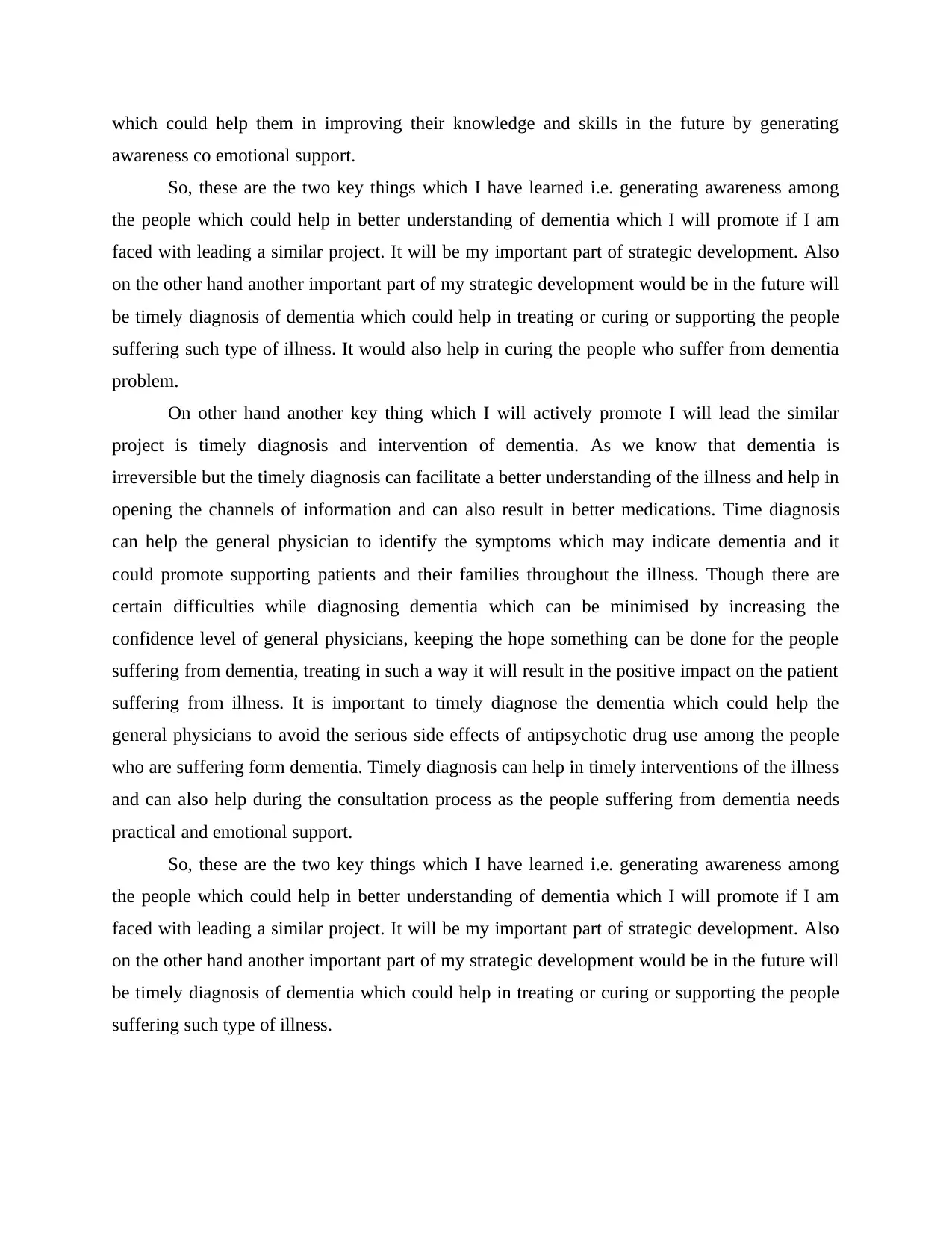
which could help them in improving their knowledge and skills in the future by generating
awareness co emotional support.
So, these are the two key things which I have learned i.e. generating awareness among
the people which could help in better understanding of dementia which I will promote if I am
faced with leading a similar project. It will be my important part of strategic development. Also
on the other hand another important part of my strategic development would be in the future will
be timely diagnosis of dementia which could help in treating or curing or supporting the people
suffering such type of illness. It would also help in curing the people who suffer from dementia
problem.
On other hand another key thing which I will actively promote I will lead the similar
project is timely diagnosis and intervention of dementia. As we know that dementia is
irreversible but the timely diagnosis can facilitate a better understanding of the illness and help in
opening the channels of information and can also result in better medications. Time diagnosis
can help the general physician to identify the symptoms which may indicate dementia and it
could promote supporting patients and their families throughout the illness. Though there are
certain difficulties while diagnosing dementia which can be minimised by increasing the
confidence level of general physicians, keeping the hope something can be done for the people
suffering from dementia, treating in such a way it will result in the positive impact on the patient
suffering from illness. It is important to timely diagnose the dementia which could help the
general physicians to avoid the serious side effects of antipsychotic drug use among the people
who are suffering form dementia. Timely diagnosis can help in timely interventions of the illness
and can also help during the consultation process as the people suffering from dementia needs
practical and emotional support.
So, these are the two key things which I have learned i.e. generating awareness among
the people which could help in better understanding of dementia which I will promote if I am
faced with leading a similar project. It will be my important part of strategic development. Also
on the other hand another important part of my strategic development would be in the future will
be timely diagnosis of dementia which could help in treating or curing or supporting the people
suffering such type of illness.
awareness co emotional support.
So, these are the two key things which I have learned i.e. generating awareness among
the people which could help in better understanding of dementia which I will promote if I am
faced with leading a similar project. It will be my important part of strategic development. Also
on the other hand another important part of my strategic development would be in the future will
be timely diagnosis of dementia which could help in treating or curing or supporting the people
suffering such type of illness. It would also help in curing the people who suffer from dementia
problem.
On other hand another key thing which I will actively promote I will lead the similar
project is timely diagnosis and intervention of dementia. As we know that dementia is
irreversible but the timely diagnosis can facilitate a better understanding of the illness and help in
opening the channels of information and can also result in better medications. Time diagnosis
can help the general physician to identify the symptoms which may indicate dementia and it
could promote supporting patients and their families throughout the illness. Though there are
certain difficulties while diagnosing dementia which can be minimised by increasing the
confidence level of general physicians, keeping the hope something can be done for the people
suffering from dementia, treating in such a way it will result in the positive impact on the patient
suffering from illness. It is important to timely diagnose the dementia which could help the
general physicians to avoid the serious side effects of antipsychotic drug use among the people
who are suffering form dementia. Timely diagnosis can help in timely interventions of the illness
and can also help during the consultation process as the people suffering from dementia needs
practical and emotional support.
So, these are the two key things which I have learned i.e. generating awareness among
the people which could help in better understanding of dementia which I will promote if I am
faced with leading a similar project. It will be my important part of strategic development. Also
on the other hand another important part of my strategic development would be in the future will
be timely diagnosis of dementia which could help in treating or curing or supporting the people
suffering such type of illness.
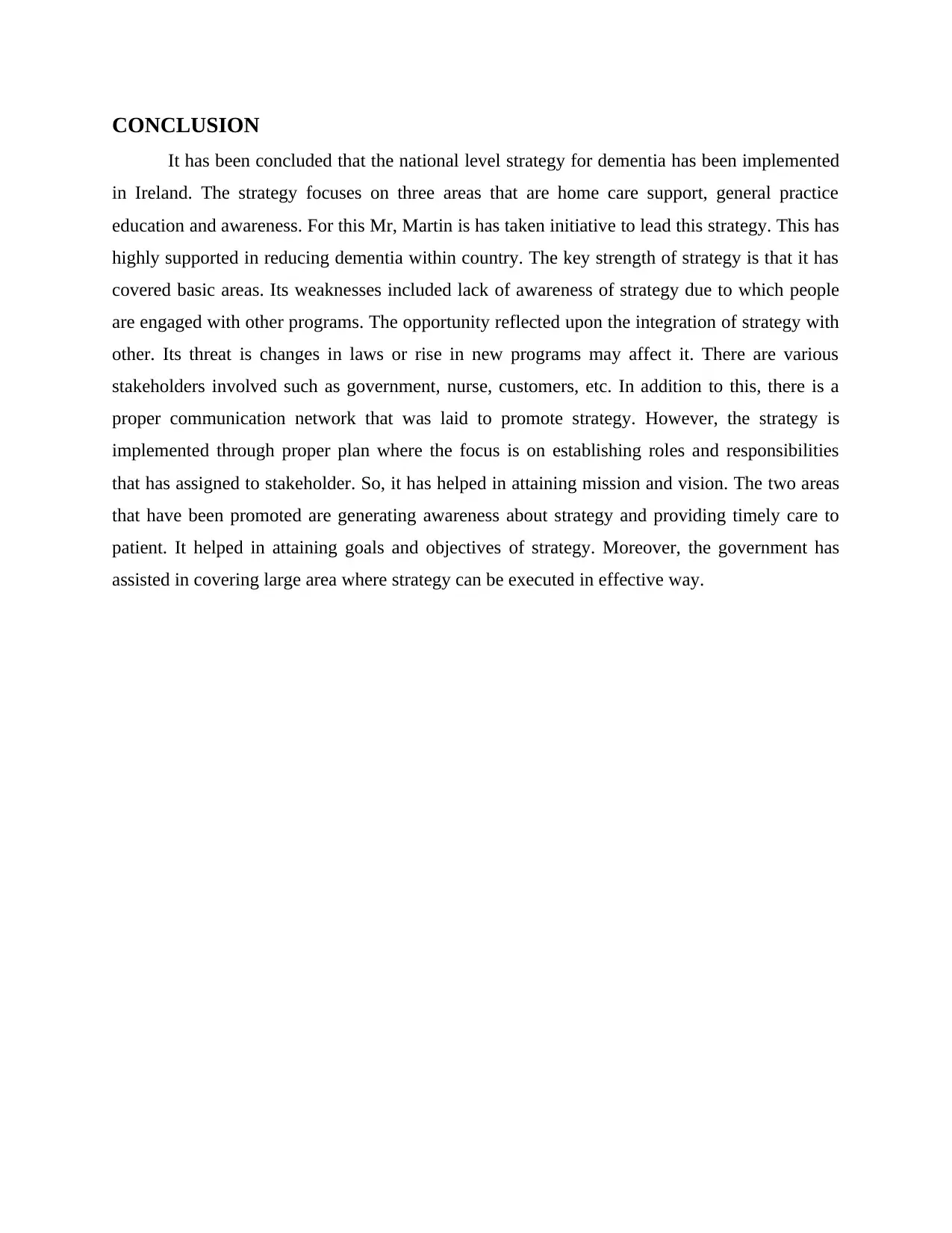
CONCLUSION
It has been concluded that the national level strategy for dementia has been implemented
in Ireland. The strategy focuses on three areas that are home care support, general practice
education and awareness. For this Mr, Martin is has taken initiative to lead this strategy. This has
highly supported in reducing dementia within country. The key strength of strategy is that it has
covered basic areas. Its weaknesses included lack of awareness of strategy due to which people
are engaged with other programs. The opportunity reflected upon the integration of strategy with
other. Its threat is changes in laws or rise in new programs may affect it. There are various
stakeholders involved such as government, nurse, customers, etc. In addition to this, there is a
proper communication network that was laid to promote strategy. However, the strategy is
implemented through proper plan where the focus is on establishing roles and responsibilities
that has assigned to stakeholder. So, it has helped in attaining mission and vision. The two areas
that have been promoted are generating awareness about strategy and providing timely care to
patient. It helped in attaining goals and objectives of strategy. Moreover, the government has
assisted in covering large area where strategy can be executed in effective way.
It has been concluded that the national level strategy for dementia has been implemented
in Ireland. The strategy focuses on three areas that are home care support, general practice
education and awareness. For this Mr, Martin is has taken initiative to lead this strategy. This has
highly supported in reducing dementia within country. The key strength of strategy is that it has
covered basic areas. Its weaknesses included lack of awareness of strategy due to which people
are engaged with other programs. The opportunity reflected upon the integration of strategy with
other. Its threat is changes in laws or rise in new programs may affect it. There are various
stakeholders involved such as government, nurse, customers, etc. In addition to this, there is a
proper communication network that was laid to promote strategy. However, the strategy is
implemented through proper plan where the focus is on establishing roles and responsibilities
that has assigned to stakeholder. So, it has helped in attaining mission and vision. The two areas
that have been promoted are generating awareness about strategy and providing timely care to
patient. It helped in attaining goals and objectives of strategy. Moreover, the government has
assisted in covering large area where strategy can be executed in effective way.
Paraphrase This Document
Need a fresh take? Get an instant paraphrase of this document with our AI Paraphraser
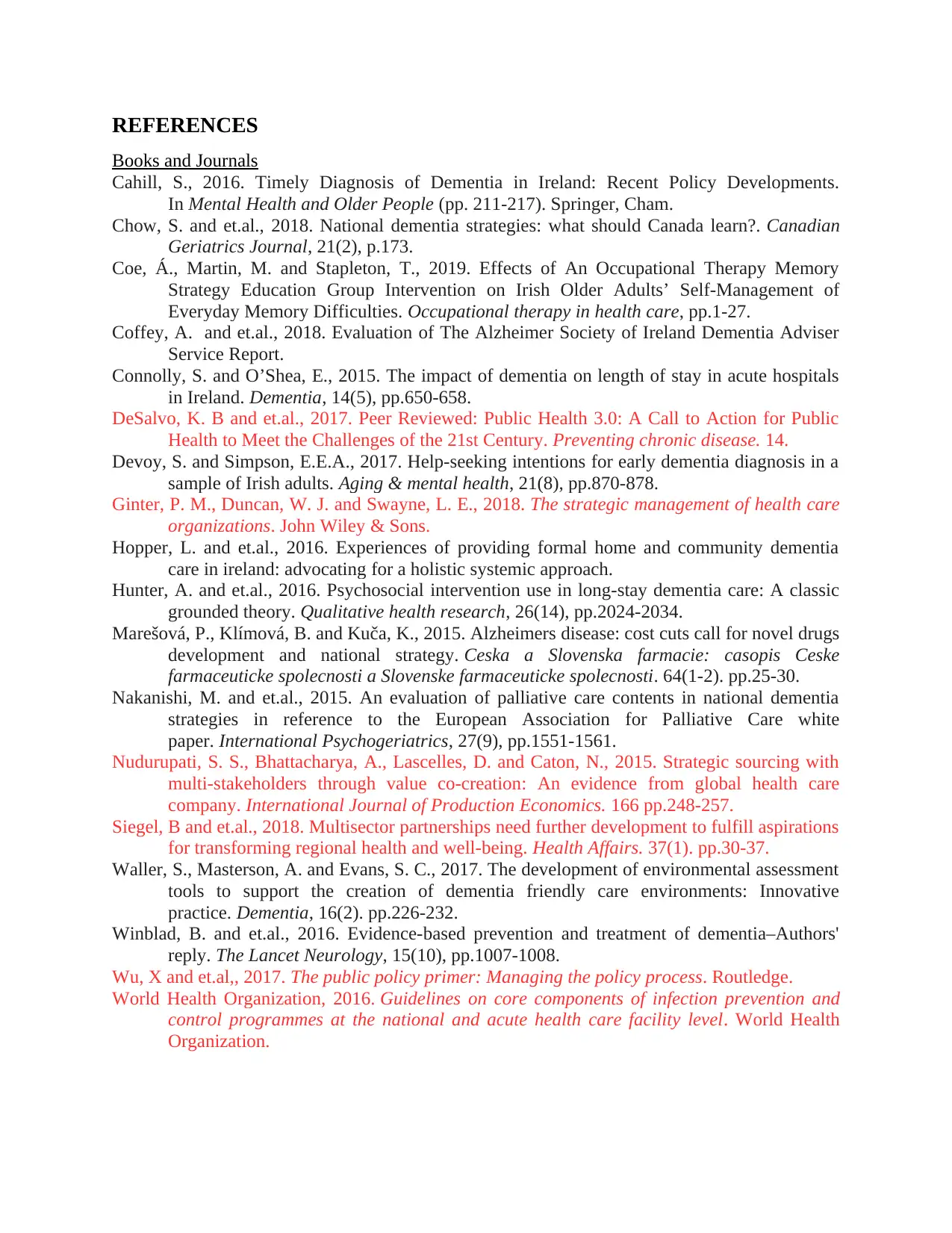
REFERENCES
Books and Journals
Cahill, S., 2016. Timely Diagnosis of Dementia in Ireland: Recent Policy Developments.
In Mental Health and Older People (pp. 211-217). Springer, Cham.
Chow, S. and et.al., 2018. National dementia strategies: what should Canada learn?. Canadian
Geriatrics Journal, 21(2), p.173.
Coe, Á., Martin, M. and Stapleton, T., 2019. Effects of An Occupational Therapy Memory
Strategy Education Group Intervention on Irish Older Adults’ Self-Management of
Everyday Memory Difficulties. Occupational therapy in health care, pp.1-27.
Coffey, A. and et.al., 2018. Evaluation of The Alzheimer Society of Ireland Dementia Adviser
Service Report.
Connolly, S. and O’Shea, E., 2015. The impact of dementia on length of stay in acute hospitals
in Ireland. Dementia, 14(5), pp.650-658.
DeSalvo, K. B and et.al., 2017. Peer Reviewed: Public Health 3.0: A Call to Action for Public
Health to Meet the Challenges of the 21st Century. Preventing chronic disease. 14.
Devoy, S. and Simpson, E.E.A., 2017. Help-seeking intentions for early dementia diagnosis in a
sample of Irish adults. Aging & mental health, 21(8), pp.870-878.
Ginter, P. M., Duncan, W. J. and Swayne, L. E., 2018. The strategic management of health care
organizations. John Wiley & Sons.
Hopper, L. and et.al., 2016. Experiences of providing formal home and community dementia
care in ireland: advocating for a holistic systemic approach.
Hunter, A. and et.al., 2016. Psychosocial intervention use in long-stay dementia care: A classic
grounded theory. Qualitative health research, 26(14), pp.2024-2034.
Marešová, P., Klímová, B. and Kuča, K., 2015. Alzheimers disease: cost cuts call for novel drugs
development and national strategy. Ceska a Slovenska farmacie: casopis Ceske
farmaceuticke spolecnosti a Slovenske farmaceuticke spolecnosti. 64(1-2). pp.25-30.
Nakanishi, M. and et.al., 2015. An evaluation of palliative care contents in national dementia
strategies in reference to the European Association for Palliative Care white
paper. International Psychogeriatrics, 27(9), pp.1551-1561.
Nudurupati, S. S., Bhattacharya, A., Lascelles, D. and Caton, N., 2015. Strategic sourcing with
multi-stakeholders through value co-creation: An evidence from global health care
company. International Journal of Production Economics. 166 pp.248-257.
Siegel, B and et.al., 2018. Multisector partnerships need further development to fulfill aspirations
for transforming regional health and well-being. Health Affairs. 37(1). pp.30-37.
Waller, S., Masterson, A. and Evans, S. C., 2017. The development of environmental assessment
tools to support the creation of dementia friendly care environments: Innovative
practice. Dementia, 16(2). pp.226-232.
Winblad, B. and et.al., 2016. Evidence-based prevention and treatment of dementia–Authors'
reply. The Lancet Neurology, 15(10), pp.1007-1008.
Wu, X and et.al,, 2017. The public policy primer: Managing the policy process. Routledge.
World Health Organization, 2016. Guidelines on core components of infection prevention and
control programmes at the national and acute health care facility level. World Health
Organization.
Books and Journals
Cahill, S., 2016. Timely Diagnosis of Dementia in Ireland: Recent Policy Developments.
In Mental Health and Older People (pp. 211-217). Springer, Cham.
Chow, S. and et.al., 2018. National dementia strategies: what should Canada learn?. Canadian
Geriatrics Journal, 21(2), p.173.
Coe, Á., Martin, M. and Stapleton, T., 2019. Effects of An Occupational Therapy Memory
Strategy Education Group Intervention on Irish Older Adults’ Self-Management of
Everyday Memory Difficulties. Occupational therapy in health care, pp.1-27.
Coffey, A. and et.al., 2018. Evaluation of The Alzheimer Society of Ireland Dementia Adviser
Service Report.
Connolly, S. and O’Shea, E., 2015. The impact of dementia on length of stay in acute hospitals
in Ireland. Dementia, 14(5), pp.650-658.
DeSalvo, K. B and et.al., 2017. Peer Reviewed: Public Health 3.0: A Call to Action for Public
Health to Meet the Challenges of the 21st Century. Preventing chronic disease. 14.
Devoy, S. and Simpson, E.E.A., 2017. Help-seeking intentions for early dementia diagnosis in a
sample of Irish adults. Aging & mental health, 21(8), pp.870-878.
Ginter, P. M., Duncan, W. J. and Swayne, L. E., 2018. The strategic management of health care
organizations. John Wiley & Sons.
Hopper, L. and et.al., 2016. Experiences of providing formal home and community dementia
care in ireland: advocating for a holistic systemic approach.
Hunter, A. and et.al., 2016. Psychosocial intervention use in long-stay dementia care: A classic
grounded theory. Qualitative health research, 26(14), pp.2024-2034.
Marešová, P., Klímová, B. and Kuča, K., 2015. Alzheimers disease: cost cuts call for novel drugs
development and national strategy. Ceska a Slovenska farmacie: casopis Ceske
farmaceuticke spolecnosti a Slovenske farmaceuticke spolecnosti. 64(1-2). pp.25-30.
Nakanishi, M. and et.al., 2015. An evaluation of palliative care contents in national dementia
strategies in reference to the European Association for Palliative Care white
paper. International Psychogeriatrics, 27(9), pp.1551-1561.
Nudurupati, S. S., Bhattacharya, A., Lascelles, D. and Caton, N., 2015. Strategic sourcing with
multi-stakeholders through value co-creation: An evidence from global health care
company. International Journal of Production Economics. 166 pp.248-257.
Siegel, B and et.al., 2018. Multisector partnerships need further development to fulfill aspirations
for transforming regional health and well-being. Health Affairs. 37(1). pp.30-37.
Waller, S., Masterson, A. and Evans, S. C., 2017. The development of environmental assessment
tools to support the creation of dementia friendly care environments: Innovative
practice. Dementia, 16(2). pp.226-232.
Winblad, B. and et.al., 2016. Evidence-based prevention and treatment of dementia–Authors'
reply. The Lancet Neurology, 15(10), pp.1007-1008.
Wu, X and et.al,, 2017. The public policy primer: Managing the policy process. Routledge.
World Health Organization, 2016. Guidelines on core components of infection prevention and
control programmes at the national and acute health care facility level. World Health
Organization.
1 out of 14
Related Documents
Your All-in-One AI-Powered Toolkit for Academic Success.
+13062052269
info@desklib.com
Available 24*7 on WhatsApp / Email
![[object Object]](/_next/static/media/star-bottom.7253800d.svg)
Unlock your academic potential
© 2024 | Zucol Services PVT LTD | All rights reserved.





